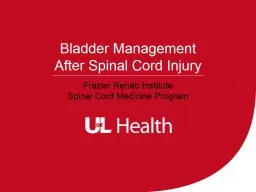

Frazier Rehab Institute Spinal Cord Medicine Program Urinary System Consists of the kidneys ureters bladder sphincters and urethra Major functions Regulates your bodys electrolytes ID: 915188
Download Presentation The PPT/PDF document "Bladder Management After Spinal Cord In..." is the property of its rightful owner. Permission is granted to download and print the materials on this web site for personal, non-commercial use only, and to display it on your personal computer provided you do not modify the materials and that you retain all copyright notices contained in the materials. By downloading content from our website, you accept the terms of this agreement.
Slide1
Bladder Management After Spinal Cord Injury
Frazier Rehab
Institute
Spinal Cord Medicine Program
Slide2Urinary SystemConsists
of the kidneys, ureters, bladder, sphincters and urethra
Major
functions:
Regulates
your body’s electrolytes
Removes
waste products and excess water (urine)
Slide3How Do You Pee?
Your
kidneys filter blood to remove waste products & produce urine
Your
urine travels through the ureters to the bladder
Your
nerves send messages up the spinal cord to the brain when bladder is ready to empty
Your
brain then sends a message down the spinal cord to the bladder telling it to empty
Your
sphincter muscles relax, your bladder muscles tighten to push urine from the bladder and the urine leaves the body through the
urethra
Slide4Urination After Spinal Cord Injury
Messages/signals
from the bladder to the brain and vice versa become disrupted or lost completely due to the SCI
Bladder
becomes dysfunctional (neurogenic)
The
level of your spinal cord injury will affect how urination will occur
Slide5Neurogenic Bladder
ReflexicBladder
AKA
Spastic bladder
SCI
above Lumbar 1-2
Reflexes
are triggered to urinate but you may not be aware
AreflexicBladder
AKA
Floppy bladder
SCI
below Lumbar 1
There
are no reflexes triggering urination
Bladder
will become too full, urine may leak and/or back up to kidneys
Slide6Bladder Management GoalsMaintain
good function of your bladder and kidneys
Develop
a realistic management
Prevent
complications
Slide7Bladder Management Programs
Options may include:
Intermittent
catheterization (IC or CIC)
Indwelling
or
Suprapubiccatheter
External
(condom) catheter
Manual
techniques to trigger voiding
Behavioral
strategies
Medications/Surgeries
Slide8Intermittent Catheterization (IC or CIC)
AKA
“in & out” catheterization
Preferred
method
Catheter
is inserted into the bladder, drains the urine then the catheter is removed
Performed
every 4-6 hours
Timing
varies depending on fluid intake
Each
IC should be less than 500cc
Slide9CathetersMany
different kinds of catheters available
Options
dependent on insurance
Briefs
can be purchased at local stores or off the Internet
Not
covered under insurance
Slide10Straight Catheters
Slide11Closed System Catheters
Slide12Male Coude’ Caths
Slide13Indwelling Catheter
Foley
Catheter
Inserted
through the urethra and remains in the
bladder, continuously
empties urine into a drainage bag
Suprapublic
Catheter
Surgically
inserted in the bladder through the
stomach, continuously
empties urine into a drainage bag
Management
Clean at
least twice a day
Change
catheter at least
monthly
Slide14External Catheters - Males
AKA
Texas or condom catheters
Beneficial
for males who experience spontaneous voiding
No
external options for females due to anatomy
F
its
over the penis and connects to drainage bag to keep you dry
Adhesive
on the condom catheter holds it in place
Must
be careful when removing to avoid skin breakdown
Slide15Other Techniques
Manual
Technique
Triggers
sphincter relaxation = involuntary bladder contraction to cause voiding
Suprapubic
tapping
Thigh
scratching
Anal/Rectal
manipulation
Increase
abdominal pressure = causes voiding
Valsalva
Crede
’
Risks
AD
Recurrent
UTI
Kidney
or bladder stones
Deterioration
of bladder or kidney
functions
Behavioral
Strategies
Timed voiding
Pelvic muscle exercises
Kegel
Slide16Surgical Procedures
Mitrofanoff
Surgical
procedure to construct a new passageway for urine using the appendix
Allows
a catheter to be passed through the abdomen and directly into bladder
Bladder
Augmentation
Surgical
enlargement of bladder
Reduces
need for frequent catheterization
Slide17Medications for Bladder Management
Help
prevent bladder spasms to promote storage
Oxybutinin
Trospium
Myrbetriq
Botuliunumtoxin
(Botox)
Helps
promote emptying
Flomax
Bethanechol
Slide18Urinary Tract Infection (UTI)
Bacteria
that multiplies in the urinary tract and can cause an infection
Slide19Signs & Symptoms of UTI
Cloudy
and/or foul smelling urine
Increase
in mucous or sediment
Increase
in bladder or
general spasms
Pain
or burning with urination
Increase
in frequency or incontinence
Low
back or flank pain
Blood
in urine
Elevated
temp/fever or chills
Nausea/vomiting
Just
not feeling well
Slide20UTI
Asymptomatic
Not
a true infection
Colonization
Presence
of odor or cloudiness alone not an indicator
Symptomatic
Increased
spasms
Incontinence
Fever
Feeling
poorly
AD
Slide21Detection & Treatment of UTI
Call
MD if you suspect UTI
May
need urine specimen (UA C&S) to determine if true infection
Treatment
may include use of
antibiotics
Slide22Ways to Prevent UTI
Proper
fluid intake
2L
daily
Routine
bladder emptying
Be
consistent with bladder management
Keep
volumes below 500cc
Good
hygiene
Proper
positioning and draining of collection device (leg bag/bedside drainage bags)
Daily
cleaning of drainage devices and proper
cleaning
of catheters
Medications
Follow
up with Urology
Slide23Conclusion
It
may take time and effort, but proper bladder management can be achieved in those with a spinal cord injury
Try
to keep a healthy urinary system by staying educated, sticking to a regimen and using preventative measures
Follow
the recommendations of your healthcare providers
Slide24References
Paralyzed
Veterans of America. (2019, February).
Retrieved
from Bladder Management Following
Spinal
Cord Injury: What You Should Know:
https
://www.pva.org
Urologic Management and Renal Disease in Spinal Cord
Injury
. (2018). In S.
Kirshblum
, & V. W. Lin, Spinal
Cord
Medicine (pp. 332-386). Demos Medical; 3
edition
.